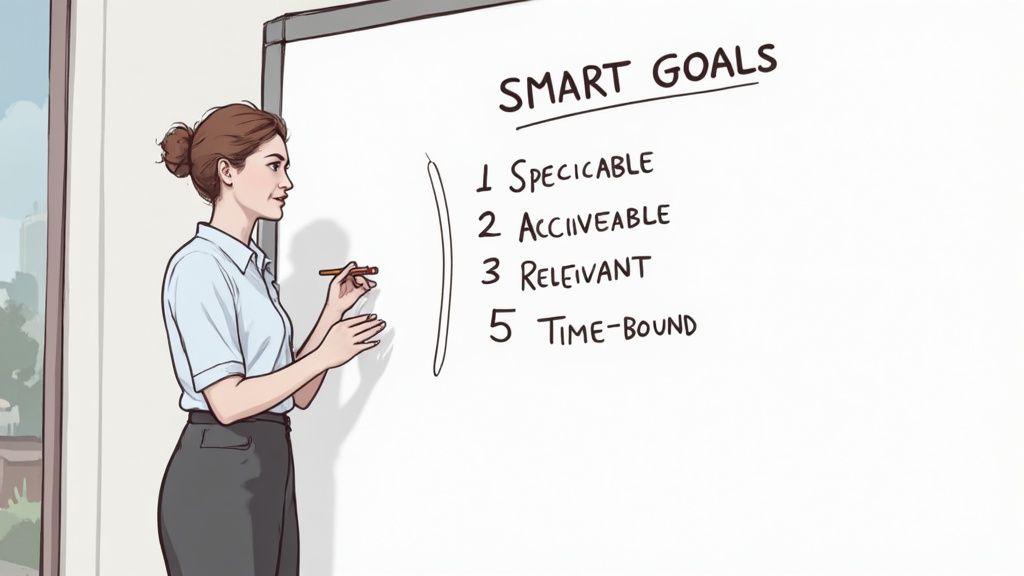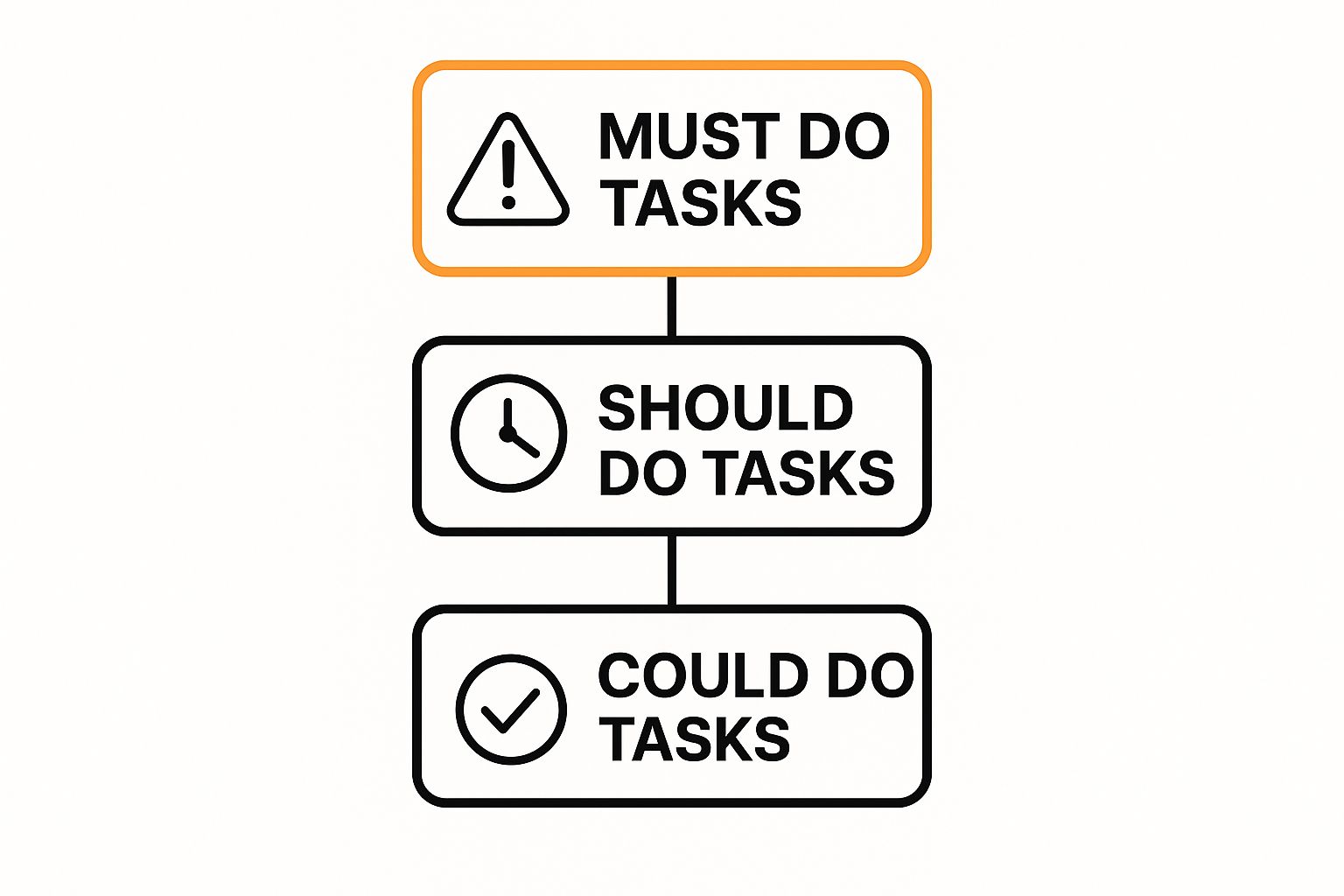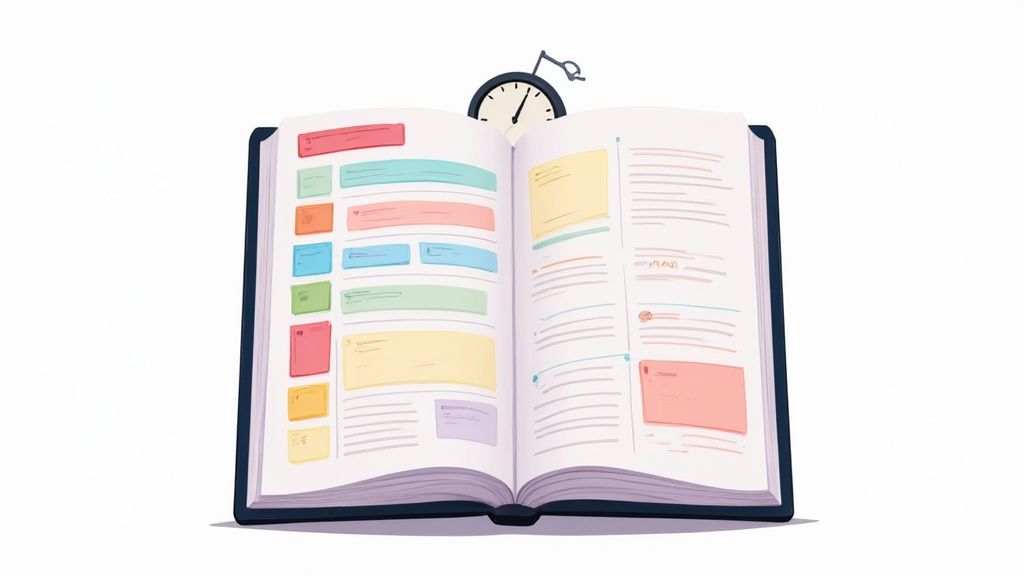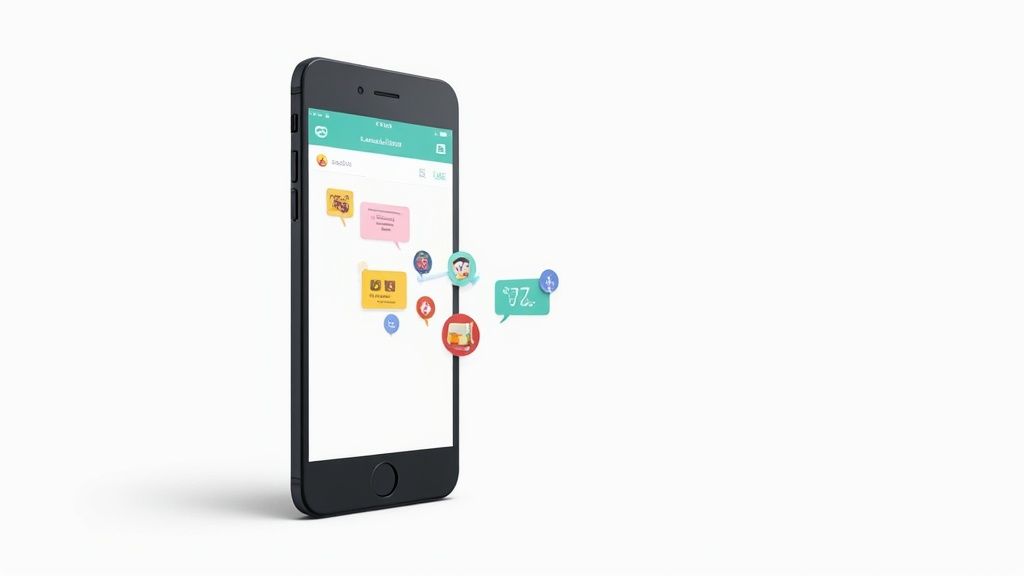A Guide to Project Management for Individuals

Staring down a big goal like "learn a new skill" or "change careers" can feel like trying to assemble a piece of complicated furniture with no instructions. It's just plain overwhelming. But project management for individuals isn't about getting tangled up in corporate red tape; it's about using simple, powerful ideas to give your ambitions some much-needed clarity and structure. Think of it as the blueprint for the most important projects in your life: your goals.
Why You Are Already a Project Manager
Here’s a little secret: you already manage projects all the time, you just probably don't call it that. Planning a vacation, organizing a family get-together, or even just spring cleaning your house are all projects. They each have a clear goal, a set of steps to get there, and a final outcome you're shooting for. The trouble starts when our goals get bigger and more complex, like switching careers or launching a side hustle. That's when our informal, "winging it" methods tend to fall apart.
A simple to-do list just doesn't cut it. Ticking off "send email" feels productive, but it completely misses the context of how that one small task fits into the bigger picture of "find a new job." This is exactly where a more structured approach becomes a game-changer, turning a scattered mess of tasks into a focused, coherent plan.
From Unofficial Manager to Confident Planner
It might surprise you, but this is incredibly common. Only 47% of projects around the world are actually managed by professional project managers. That means the vast majority are led by people just like you, taking charge without a formal certificate. On top of that, 71% of companies believe their teams need to build better skills in this area, showing a clear demand for people who know how to get things done. You can explore more about these project management statistics and see just how valuable these skills are becoming.
The point of personal project management isn't to make your life more complicated. It's to clear out the mental clutter by building a system you can actually trust. This frees up your brainpower so you can focus on what really matters—making real progress.
Getting into this mindset is the first, most important step. It's about realizing that the same principles that guide multi-million dollar corporate projects can be scaled down to help you achieve your own personal breakthroughs.
A New Way to Tackle Your Goals
Instead of a to-do list that feels like a laundry list of chores, imagine having a central command center for each of your big goals. A tool like Obsibrain helps you build exactly that, turning vague ambitions into solid, actionable plans.
For a career change: You could set up a dedicated project space in Obsibrain to track job applications, keep notes on networking contacts, and gather skill development resources, all in one spot.
For learning a new skill: You could outline a complete learning path in an Obsibrain note, link directly to tutorials, and set weekly milestones using tasks to see your progress unfold.
For a side hustle: You could manage all your client details in Obsibrain, track every project task on a slick Kanban board, and store all your notes and invoices together.
This guide will walk you through moving beyond basic checklists. You'll learn how to use a dedicated tool to turn that blueprint for your ambitions into a real system you can rely on every day. It's time to transform the chaos into focused, deliberate progress.
Mastering the Core Principles of Personal Projects

To make real, tangible progress on your personal goals, you have to move beyond a simple to-do list. You need to start thinking like a project manager, but without all the corporate buzzwords. It all boils down to translating three powerful ideas into your personal life: scope, timelines, and resources.
Let's take a common goal: "get fit." It’s a great ambition, but it's way too fuzzy to act on. This is where defining your scope is critical. Scope just means drawing a clear circle around what you actually intend to do. Does "get fit" mean walking 30 minutes three times a week, or are you training to run your first 5K? Nailing down the scope is the first real step toward a plan you can follow.
Next up, every project needs a timeline. This isn’t about slapping stressful deadlines on yourself. It's about creating a realistic schedule that works with your life, not against it, while still creating momentum. A personal timeline is what turns a vague "someday" goal into a "this-month" goal.
Defining Your Most Valuable Resources
Finally, you have to get honest about your resources. In a business, that means money and people. For you, the most precious resources are your time, energy, and focus. These are finite, and learning to allocate them wisely is how you avoid burnout and make consistent progress.
This is exactly where most personal projects go off the rails. Even in the professional world, where people are paid to do this, execution is a massive hurdle. A shocking 52% of organizations don't consistently create a scoping document, and only 48% reliably set a baseline schedule. For you, this is a huge opportunity. By simply adopting these basic practices, you can dodge the most common pitfalls and give your goals the structure they need to thrive. You can discover more insights about project management statistics on monday.com.
A goal without a clear scope, timeline, and resource plan is just a wish. By defining these elements upfront, you transform that wish into a concrete objective with a high probability of success.
This initial planning phase is what separates dreaming from doing. It’s the clarity you need to take that first, meaningful step.
Crafting Your Personal Project Brief in Obsibrain
The best way to make these ideas stick is to create a Personal Project Brief for each of your big goals. This isn't some fifty-page report; it's a simple but powerful note you can build right inside Obsibrain. Think of it as the North Star for your ambition. For example, for a "Learn Spanish" project, this brief in Obsibrain could contain links to your favorite language apps, a schedule for your study sessions, and your core motivations to keep you inspired.
Your Personal Project Brief should answer a few straightforward questions:
The Objective: What’s the main thing you want to accomplish? (e.g., "Build a personal website to showcase my portfolio.")
The Scope: What, specifically, is included? And just as important, what isn't? (e.g., "Included: A 3-page site with a gallery and contact form. Not included: A blog or e-commerce features.")
Success Metrics: How will you know when you’re done? (e.g., "The website is live, and three friends have tested the contact form successfully.")
Timeline: What's your target completion date? (e.g., "Go-live date is six weeks from today.")
Resources: What time, energy, and tools are you committing? (e.g., "Four hours every Saturday morning, using a specific web builder tool.")
By drafting this brief in Obsibrain, you create a central hub for your project. You can link to it from your daily notes, connect it to research, and use it to keep your tasks on track. It becomes the single source of truth that ensures every little action you take is moving you closer to the finish line.
How to Organize Your Life With the P.A.R.A. Method
If you've ever felt like you're drowning in a sea of digital files, random notes, and ideas you half-forgot, you know how much it can crush your productivity. A cluttered digital space leads to a cluttered mind. This is a huge roadblock in project management for individuals, but thankfully, there’s a brilliantly simple system to bring back order: P.A.R.A.
P.A.R.A. is an organizational framework that stands for Projects, Areas, Resources, and Archives. This isn't about creating more busywork for yourself. It’s about building a dynamic system that sorts information based on how actionable it is. Think of it like building a personal library where every single book has a specific shelf, making it effortless to grab exactly what you need, right when you need it.
The Four Pillars of P.A.R.A.
The beauty of this system is that it gives every single piece of information in your life a dedicated home, turning chaos into absolute clarity. The real goal is to cut down on the mental friction of figuring out where to put something so you can spend your energy actually doing the work.
Let’s break down the four core components:
Projects: These are your active goals with a clear, defined finish line. A project always has a beginning and an end. Think of things like "Plan Summer Vacation," "Complete Q3 Sales Report," or "Launch Personal Website."
Areas: These are the ongoing responsibilities and standards you maintain in your life. Areas don't really end; they are continuous. Examples here include "Personal Finance," "Health & Fitness," or "Client Management."
Resources: This is your personal knowledge library—a collection of topics, interests, and reference materials you want to hold onto. This is where you'd keep notes on "AI Articles," "Favorite Recipes," or "Book Summaries."
Archives: This is simply cold storage for anything that's no longer active. We're talking about completed projects, areas of your life that are no longer relevant, or resources that have become obsolete. This keeps your active workspace clean and focused.
By sorting your information this way, you create a powerful separation between what’s immediately actionable (Projects) and what's there for reference (everything else).
Implementing P.A.R.A. in Obsibrain
The true magic of P.A.R.A. really comes alive inside a flexible tool like Obsibrain. You can set this entire system up using folders or a network of linked notes—whatever feels more natural to you. A great use case is for home management; an "Areas" folder for "Home" can contain notes for "Maintenance Schedule" and "Appliance Manuals," while an active "Projects" folder for "Kitchen Renovation" pulls everything together for that specific goal.
For example, a project like "Renovate the Kitchen" would live in your Projects folder. Inside that project note, you can link to research on countertops from your Resources, track spending related to your "Household Budget" Area, and once that final tile is laid, you just move the entire project over to your Archives.
This infographic gives a great visual breakdown of how you might prioritize the tasks that pop up from these different categories.

The image clearly separates tasks into "Must Do," "Should Do," and "Could Do" tiers, which is perfect for helping you focus on what's truly essential at any given moment.
The P.A.R.A. method isn't just about filing; it's a dynamic system for managing focus. By keeping your active projects separate from your reference material, you dramatically reduce distraction and can immediately see what requires your attention.
Getting this up and running is surprisingly straightforward. You can create the four main folders in Obsibrain in just a few minutes. To get you started on the right foot, you can learn more about creating a P.A.R.A. folder structure in Obsibrain with our detailed guide. It’ll walk you through the process step-by-step to build a solid foundation.
To put it into practice, here is a simple table showing how you can map the P.A.R.A. categories directly into your Obsibrain setup.
How to Implement P.A.R.A. in Obsibrain
Projects
Short-term efforts with a clear goal and deadline.
Launch New Website
Areas
Long-term responsibilities you need to maintain.
Health & Fitness
Resources
Topics of ongoing interest and reference materials.
Favorite Recipes
Archives
Inactive items from the other three categories.
Completed Projects
Using this structure as your guide, you'll find that organizing your digital life becomes second nature.
A Practical P.A.R.A. Workflow Example
So, what does this look like day-to-day? Let's say you're browsing the web and come across a fascinating article on productivity techniques. Where does it go?
Capture It: First, you use Obsibrain's Quick Capture to save the article so you don't lose it.
Organize It: Next, you ask yourself a simple question: "Is this for a specific project I'm working on right now?"
Route It: If the answer is no, it’s not for an active project. Is it related to an ongoing area of responsibility, like "Professional Development"? Maybe. But if it’s just a topic of general interest, it belongs in Resources, probably under a note like "Productivity Tips."
This simple decision-making process, when you repeat it over time, builds an incredibly organized and trustworthy second brain. It ensures that when you finally sit down to work on your projects, your workspace contains only what's relevant to those projects, giving you the crystal-clear focus you need to make real progress.
Bringing Your Goals to Life with SMART and Kanban

So, you’ve decluttered your digital life with a system like P.A.R.A., and your workspace is finally clear. That’s a huge win. Now, it’s time to shift gears from simply organizing information to actually driving action. This is where we’ll bring in two of the most powerful techniques in modern productivity: SMART goals and Kanban boards.
One of the biggest reasons personal projects fizzle out is because the goals are just too vague. Ambitions like "write more" or "get in shape" sound great, but they don't give you a clear path forward. It’s like trying to navigate a ship without a destination on the map. This is where the SMART framework comes in, turning a fuzzy wish into a concrete target you can really sink your teeth into.
Defining Your Destination with SMART Goals
SMART is a simple acronym that acts as a checklist for creating powerful, actionable goals. It's a cornerstone of project management for individuals because it forces you to stop and think through the nitty-gritty details of what you actually want to achieve.
Here’s a breakdown of what each letter means:
Specific: Your goal needs to be crystal clear. Instead of "write more," a specific goal is "write a blog post."
Measurable: How will you track your progress and know when you’ve hit the mark? The goal becomes "write a 500-word blog post."
Achievable: Is your goal realistic? Setting out to write a novel in one week is a surefire recipe for burnout and failure.
Relevant: Does this goal actually matter to you? Writing a blog post is relevant if your bigger ambition is to build an online presence.
Time-bound: Every goal needs a deadline. This creates a healthy sense of urgency and a finish line to aim for.
When you put it all together, a vague idea like "write more" transforms into a truly powerful SMART goal: "Write two 500-word blog posts per week for the next month." Now that's a clear destination. You know exactly what success looks like and when you plan to get there.
By translating your aspirations into SMART goals, you’re not just making a to-do list; you’re drawing a detailed map. Every element provides a coordinate, guiding your daily actions and making it far easier to stay on course.
This process is incredibly easy to set up inside Obsibrain. You can dedicate a section in your main project note to outline your SMART goals, keeping your core objectives front and center. For a more advanced setup, you can learn how to create and manage your objectives with SMART Projects in Obsibrain, which gives you a robust framework for tracking your progress.
Visualizing Your Workflow with a Kanban Board
A SMART goal gives you a destination, but a Kanban board provides the visual roadmap to get you there. Originally developed for manufacturing, this brilliantly simple system is perfect for personal project management because it makes your workflow tangible. It clearly answers the question, "What should I be working on right now?"
A personal Kanban board usually has three simple columns:
Backlog (or To Do): This is where all your tasks and ideas live before you’ve started them.
In Progress: When you decide to tackle a task, you move it here. This column should have a strict limit—ideally just one or two items at a time—to keep you focused.
Completed (or Done): Once a task is finished, you move it here. This creates a satisfying, visual record of everything you've accomplished.
Let’s say your goal is to "Plan a Weekend Trip." Your Backlog could have cards for "Research destinations," "Book hotel," and "Create packing list." When you start looking at hotels, you move the "Book hotel" card to In Progress. Once it's all booked, you get to triumphantly slide it over to the Done column. A great use case in Obsibrain is creating a "Job Search" Kanban board. The columns could be "Applied," "Interviewing," and "Offer," giving you a clear visual of your entire pipeline at a glance.
This visual flow is incredibly motivating. It stops you from feeling overwhelmed by a massive to-do list and instead encourages you to focus on moving one small piece of the project forward at a time. Within Obsibrain, you can easily create Kanban boards for each of your projects, linking individual task cards back to more detailed notes or research. This combination of defined goals (SMART) and a visual workflow (Kanban) creates a powerful engine for progress, helping you celebrate small victories on your way to achieving your biggest ambitions.
Building a Side Hustle: An Obsibrain Case Study
Theory is great, but seeing a system work in the real world is where the magic happens. Let's follow a practical case study to see how all these ideas—P.A.R.A., SMART goals, and Kanban boards—come together inside Obsibrain. Meet Alex, an aspiring designer ready to build a freelance side hustle from the ground up.
Alex’s first move is to bring the P.A.R.A. method to life. Inside Obsibrain, they create a new top-level folder: P - Projects. Within that, a single note is born: [Project] Freelance Design Business Q1. Just like that, this one note becomes the command center for the entire venture, giving the goal a home and immediate structure.
Setting a Clear and Actionable Direction
With a project "container" in place, Alex's next job is to figure out what "success" actually looks like. Instead of a vague hope like "get some clients," Alex sits down and hammers out a SMART goal right inside the main project note. This simple act provides instant clarity and a real target to aim for.
Here’s what Alex’s first SMART goal looks like:
Specific: Land three paying clients for logo design services.
Measurable: Track the client count from 0 to 3.
Achievable: Three clients in a single quarter is a stretch, but totally doable for a motivated new freelancer.
Relevant: This goal feeds directly into the larger mission of building a sustainable side hustle.
Time-bound: Nail this down by the end of the first quarter (March 31st).
Suddenly, the project isn't just a fuzzy idea anymore. It’s a concrete mission.
Connecting the Dots with Obsibrain
Now, Alex starts to build out the different pieces of the project. Using Obsibrain's powerful bi-directional linking, every snippet of information becomes part of a bigger picture. When a promising lead comes up, a new note for Client A Prospect is created in the A - Areas folder, filed under Client Management. Inside that client note, Alex links straight back to the main [Project] Freelance Design Business Q1 note for context.
At the same time, Alex is researching how to price design work. Every useful article and pricing guide gets saved as a note in the R - Resources folder under a Design Business topic. Here’s the key part: Alex links those pricing notes directly to a task called Develop Service Packages. Now, that critical info is just one click away, right when it's needed most.
This interconnected web of notes is what separates a true personal project management system from a simple to-do list. It creates context and ensures that information isn’t just stored—it’s integrated directly into the workflow.
This kind of skill is becoming more valuable than ever. The global project management job market is exploding, with a projected need for 25 million new professionals by 2030. This growth isn't just in big corporations; it's fueling a massive 'project economy' where freelance and side-hustle opportunities are everywhere. By mastering these skills, people like Alex can tap directly into this trend, where being able to manage a project well is a serious advantage. You can read more about the growth of the project economy and the doors it's opening.
Visualizing Progress with a Kanban Board
With goals defined and notes organized, Alex’s final step is to build a visual workflow. Right inside the [Project] Freelance Design Business Q1 note, Alex sets up a simple Kanban board with three columns: To Do, In Progress, and Done.
The board gets filled with actionable tasks pulled straight from the SMART goals:
To Do:
Create Portfolio WebsiteDevelop Service PackagesDraft Cold Email TemplateSend 10 Cold Emails
In Progress:
(Starts empty)
Done:
(Also starts empty)
The moment Alex starts designing the portfolio website, that card gets dragged into In Progress. This visual system instantly shows what to work on next, cuts through the feeling of being overwhelmed, and delivers a satisfying hit of momentum as cards move from left to right. This case study is a repeatable blueprint for applying project management for individuals to turn any big idea into a structured, achievable reality.
Frequently Asked Questions About Personal Project Management

Jumping into the world of personal project management for the first time usually brings up a handful of questions. It's totally normal. Adopting any new system can feel like a big leap, but rest assured, these frameworks are built to be flexible and grow right alongside you. Let's tackle some of the most common concerns I hear.
Lots of people worry that a system like this is overkill for their simple, day-to-day goals. That's a fair point, but the beauty here is its scalability. The whole point is to bring clarity, not create a bunch of red tape for yourself.
Think of it this way: for a simple goal like "plan a birthday dinner," your project inside Obsibrain might just be a single note with a quick checklist. But for a massive ambition like "learn to code," you can build out a full-fledged dashboard with Kanban boards, linked research notes, and detailed timelines.
You are always in the driver's seat. You get to decide how much complexity you need. Start with the simplest possible version that gets the job done and only add more structure when the project truly calls for it.
How Is This Different from a To-Do List?
This is a big one. How is this any different from the to-do list app I already use? A standard to-do list is fantastic for tracking disconnected tasks, like "pick up milk" or "call the dentist." They're standalone items.
A real project management system, on the other hand, is built for interconnected tasks that all ladder up to a larger, more meaningful goal.
A to-do list might tell you to "buy lumber," but it offers zero context. In contrast, your Obsibrain setup links that task directly to the "Build a Bookshelf" project. It connects it to your design schematics in your Resources folder and places it visually on your workflow. It's a fundamental shift from just doing random tasks to actively orchestrating a result. A perfect use case is managing a creative project, where a single task in Obsibrain can link to brainstorming notes, visual mood boards, and feedback from collaborators, all within the context of the main goal.
How Much Time Does Setup Take?
Getting a system like P.A.R.A. up and running in Obsibrain is probably faster than you think. Honestly, you can create the four main folders—Projects, Areas, Resources, and Archives—in less than an hour.
The key is not to feel pressured to organize your entire digital life on day one. That’s a recipe for burnout. A much better approach is to start small. Just organize your very next project using the system and build the habit from there. For example, your first project in Obsibrain could be as simple as "Plan Weekend Trip," containing just one note with a checklist and booking confirmations.
The real magic happens through consistent, daily use, not some mythical, perfect initial setup. For more specific setup steps and answers to other common questions, you can always check out our detailed Obsibrain FAQ documentation.
Last updated
Was this helpful?